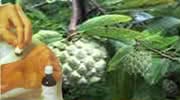 The Atis Lotion Mosquito Repellent was formulated using the extracts of Atis (Anona squamosa) leaves mixed with other locally available materials.
The Atis Lotion Mosquito Repellent was formulated using the extracts of Atis (Anona squamosa) leaves mixed with other locally available materials.
It uses a washable, mineral oil – based formulation and its biodegradable since, it is derived from advantage against other well known repellents which are chemical based in formulation. The Atis Lotion is composed of: 10.125% mineral oil, 1.02% Sodium Carboxymethyl Cellulose, 9% Propylene Glycol, 0.22% Methyl Paraben, 0.135% Propyl Paraben, 70% water, and 10% plant extract.
Application of the Technology:
Atis Lotion Mosquito Repellent is a personal care products used in preventing mosquito bites which cause itchiness, inflammation and discomfort to individuals.
Possible Areas of Technology Application:
Atis Lotion is a practical alternative in preventing incidence of mosquito – borne diseases like dengue, malaria, and filariasis especially in areas where incidence is high.
Market:
As of 2000, Philippine population stood at 85 million Filipinos. Figures show an average annual rate of increase of 2.3% from 1995 to 2000. The estimate for 2007 is 88.7 million and 94 million Filipinos for 2010.
Out of total population of 85 million, 48.5% are located in the urban areas and 51.5% are located in rural areas.
The population growth is worth considering since the product to be marketed is a consumer product whose potential demand directly grows as the populations grows.
Indeed, atis is considered as among the country’s important crops given its various uses not only for food but more for natural medicines.
The leaves, bark and seeds contain alkaloid and chloroplatinate, a group of nitrogen-containing compounds that are physiologically active as poisons or drugs that are used as ingredients for medicines that kill lice, Tomas Briñas said, the regional director for Bicol of the DOST.
The flesh of the fruit, he said is reported to contain upwards of 10 percent of sugar, mostly glucose at 5.40 percent and some fructose of 3.60 percent.
In the Philippines the leaves are applied as a poultice to children with dyspepsia. Crushed seeds with coconut oil are applied on the scalp to rid it of lice. A decoction of the seeds is used as an enema for the children with dyspepsia.
According to Sanyal and Ghose, externally the leaves, the unripe fruit, and the seeds which contain acrid principle possess vermicidal and insecticidal properties.
The crushed seeds, in a paste with water, are applied to the scalp to destroy lice.
The same is used as an abortifacient if applied to the uteri in pregnant women.
The bruised leaves, with salt, make a good cataplasm to induce suppuration and fresh leaves crushed between the fingers and applied to the nostrils cut shorts fits and fainting.
The ripe fruit, bruised and mixed with salt, is applied as a maturant to malignant tumors to hasten suppuration. The unripe fruit is astringent and is given in diarrhea, dysentery and atonic dyspepsia.
The bark, according to Briñas has been reported by Nadkarni as a powerful astringent and tonic to stop diarrhea. The leaves are used as an anthelmintic and its decoction for rheumatic baths to alleviate pain.
For infected insect bites, juice extract after pounding an unripe fruit is applied directly to affected parts three times a day to cure the infection.
The seeds are considered a powerful irritant to the conjunctiva while the roots are considered a drastic purgative.
Atis tree is small that grows only three to five meters high. Its leaves are hairy when young, oblong, eight to 15 centimeters long, with a petiole one to 1.5 centimeters long.
Flowers occur singly in the axils of the leaves, about 2.5 cm long, pendulous, three-angled, light green to yellow.
Fruit is large, slightly heart-shaped, six to nine centimeters long, the outside with knobby polygonal tubercles. When ripe, the fruit is light yellowish-green
The PCHRD studies also revealed that atis possesses anti-inflammatory properties as it yielded two new cyclic peptides, cyclosquamosin H and I, together with six known cyclic peptides, squamin A, squamin B, cyclosquamosin A, D E and cherimolacyclopeptide B from the seeds. Compound 7 showed an inhibitory effect on the production of pro-inflammatory cytokines.
Extracts of atis fruit pericarp was also tested for cytotoxic activity against Dalton’s lymphoma cells and HeLa cells.
The chloroform extract was found cytotoxic to the different cell lines tested and suggests the potential for AS fruit pericarp for the development of treatment for cancers.
The PCHRD said atis has an antihyperglycemic effect and alleviated liver and renal damage associated with STZ-induced diabetes mellitus in rats.
The diabetic groups treated with aqueous leaf extract were compared with standard glibenclamide.
As hepatoprotective the study on diethylnitrosamine-induced liver injury in Swiss albino mice showed hepatoprotective effect, with improvement in biochemical parameters and confirmation by histopathological studies.
The PCHRD also said that the ethanol crude extract of the fruit of atis for antimicrobial activity against some pathogenic microorganisms showed inhibitory activity against S aureus and S pneumoniae.
Results conclude the plant extract may serve as a valuable source of compounds with therapeutic antibiotic potentials.
Likewise, phytochemical study revealed the presence of quercetin in the atis seed extract and the results of the effects of quercetin suggest an involvement of this phytochemical in the mediation of antithyroidal activity, it added. (PNA)
Agency In-charge:
Philippine Council for Health Research and Development
Source and Image: osist.dost.gov.ph
Do you like this money making business idea? then please consider subscribing to our RSS feed and have new articles sent directly to your inbox. (Once you entered your e-mail address, you need to login to your e-mail account and click the link to confirm your subscription).




as said, things around as has their indivividual uses.
all atis were not trow there is a uses.
like
It is always the best to make something out of natural and its best for our environment. I like your post its helpful.